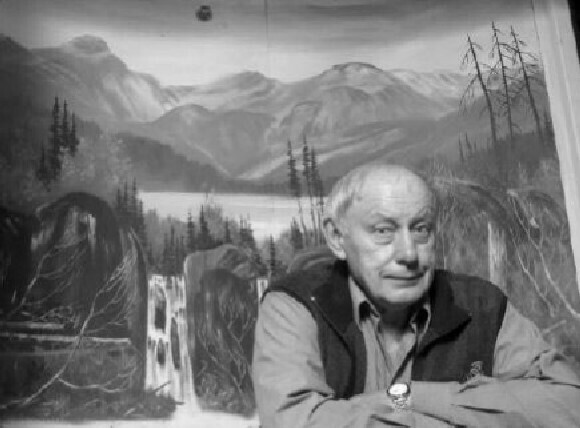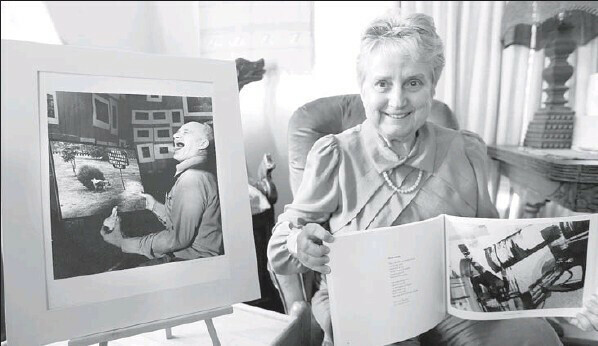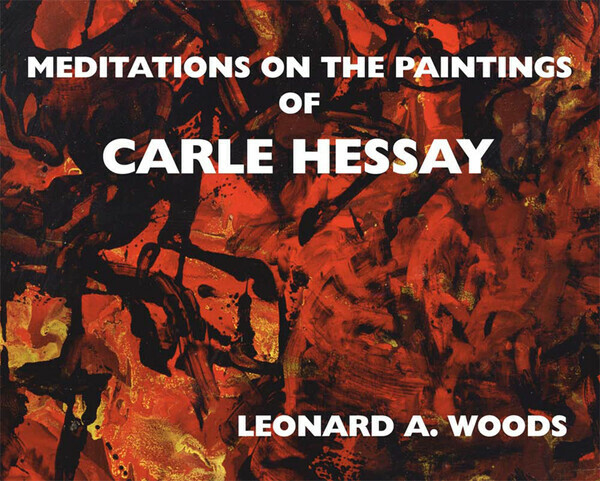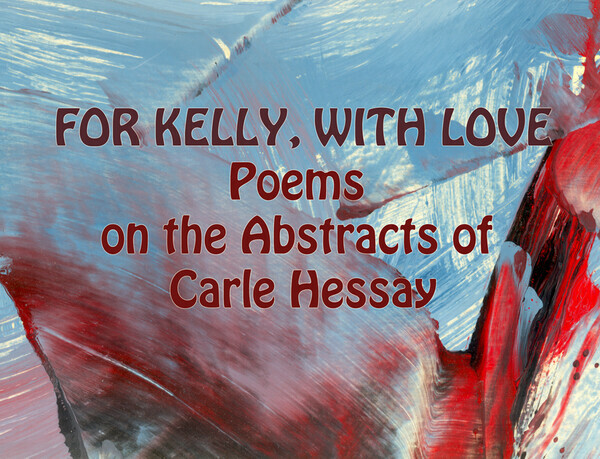A. Two books have been published featuring Carle Hessay's art.
The first book is by Leonard A. Woods, Meditations on the Paintings of Carle Hessay (Trabarni, 2005).
Please click on the image above to view the PDF of the entire book.
A printed hardcover of this book is now on sale, reduced from $36.00 to $25.00 (including shipping). Please order from carlehessay@gmail.com
The second book is For Kelly, With Love: Poems on the Abstracts of Carle Hessay (Treeline, 2014).
The power of abstract art and how it reaches the inner life of each viewer in different ways and at different levels is vividly demonstrated in this collection. Yet, in combination, the poems also draw out those elements that ring true for who Carle Hessay was as a person and an artist. In their reach, they also define what abstract art is and why it is still relevant in the 21st century. The introduction contextualizes Carle Hessay's dynamic abstract paintings in relation to the forces and ideas that characterized abstract expressionism in the mid twentieth century. Poets include Karen Ballinger, bill bissett, Dorothy Field, Patrick Friesen, Corinna Gilliland, Judith Heron, Eve Joseph, Linda Olson, Barbara Colebrook Peace, Linda Rogers, Carol Ann Sokoloff, Gray Sutherland, Leonard A. Woods, Patricia Young, Terence Young, and Gail D. Whitter.
Please click on the image above to view the PDF of the entire book.
For videos of the book launch exhibition and poetry readings, the Colour and Sound series, see:Highlights of the 4 day series of readings at :https://www.youtube.com/watch?v=cs5Hi4WDIZk
or to watch each event see:
Colour and Sound Part 1: https://www.youtube.com/watch?v=dtqqhpp1kFI
Colour and Sound Part 2: https://www.youtube.com/watch?v=1qt2_937A6o
Colour and Sound Part 3: https://www.youtube.com/watch?v=YW4VcRGwZVY
Colour and Sound Part 4: https://www.youtube.com/watch?v=oynOh2-Sbac
This book is now on sale, reduced from $36 to $25 (including shipping). Please order from carlehessay@gmail.com
Order both Meditations on the Paintings of Carle Hessay by Leonard A. Woods and For Kelly With Love: Poems on the Abstracts of Carle Hessay for a reduced price of $40.
___________________________________________________________________________________
B. Reviews, comments, and articles about Leonard A. Woods, Meditations on the Paintings of Carle Hessay (Trabarni, 2005)
1. "It is the story of a friendship and the re-discovered treasures of Carle Hessay’s paintings....Woods' love for the arts and longtime friendship with Hessay inspired him to write the book....Hessay had an appreciation for Native art, which made him well-connected with local Aboriginal groups. He would go to the native reserves where no other white man was allowed to go. They loved him there." (Marten Youssef, The Langley Times, 2005)
2. “Absolutely marvelous. Congratulations for a truly beautiful and inspiring production.” (Martin Segger, Director, Maltwood Art Museum and Gallery, University of Victoria)
3. "It is a joy and a comfort to have because it reminds me of B.C. Some of Carle Hessay’s work is very reminiscent of the Group of Seven, but it has its own distinct style. That Wake for a Shuswap is an amazing picture -- the lighting is stunning, and it is fascinating that the body is unseen, as if only the spirit matters now. The Forgotten Logging Camp is so peaceful -- and hopeful! And the Xerxes one is so different again. I love the idea of him reading Greek Classics in the wilderness." (Professor Kathryn Kerby-Fulton, University of Notre Dame)
4. "Leonard Woods studied with Lemoine Fitzgerald, the only prairie representative of the Group of Seven. Woods served with the Canadian Air Force from 1940 to 1943, was wounded, and received rehabilitationtraining at the Ontario College of Art. Meanwhile Woods had reopened the Sculpture Department at the Vancouver School of Art, and Vancouver and Langley, where he had grown up, would become his future homes. Woods’s long friendship with Hessay has naturally deepened the insight he brings to his “Meditations” on Hessay’s art. Hessay’s artwork dates from the late 1950s, when romantic realism waspopular. His colours are typically dark yet vivid. He would mature artistically in the late 1960s, when his full energies as a painter were released in bold slashes to celebrate a world “in its primeval perfection,” namely the mountainous world of British Columbia that he knew so well. Curiously, his paintings manage to be both strange and familiar. Hessay occasionally painted urban scenes, shown here in a chapter called “The Great City,” which celebrated man-made urban wilderness scenes just before dawn. One that Woods called “The Number of Man” reminds him of the revelation of St. John the Divine. It bears the burden of prophecy and dates from the final decade of Hessay’s activity as an aging artist. The painting’s colours—red andblack—along with heaps of human bones suggest a medieval vision like those painted by Hieronymus Bosch. Woods notes that the skeletons move toward the viewer, “trampling and crashing all in its unchallenged way.” Hessay’s last painting suggests calm, peace, and reconciliation. The artist died from a heart attack that occurred while he was dancing at a New Year’s party in 1978. Woods calls it his last will andtestament: “Before us lies the awakening of a new day, sweetened and purged of all undesirable things.” The book’s helpful format contributes substantially to the enjoymentof readers. A full page of text is set opposite each full-pageillustration of a Hessay painting. The reader, with an open book on his or her lap, can indeed “meditate” on the paintings. (Canadian Book Review Annual)
5. Brenda Anderson, "Inspired by Nature." Langley Times (December 22, 2006):
THE LANGLEY TIMES (Dec. 22, 2006)

Photo by Rob NEWELL. Jim Sydor, a member of Langley Evangelical Free Church, stands with a mural painted by his friend CarleHessay in 1967. When the church is remodelled within the next five years or so, the mural will be moved to Langley Community Music School.
Inspired by nature
By Brenda Anderson
An impressive work of art by a rather colourful character has been tucked away in a Langleychurch for nearly 40 years, but a change is on the horizon that will one day see it displayed to amuch broader audience.
Since 1967, the east wall of the Langley Evangelical Free Church at the corner of 208 Streetand 48 Avenue has featured a mural by the late Carle Hessay, a German-born landscape artistwho made his home in Langley for nearly three decades.
The six-foot by nine-foot image features blue-grey mountain peaks rising in the distance. Before them, a glassy lake is skirted by evergreen and deciduous forest. And in the foreground,a pair of waterfalls thunder down between giant black boulders amidst a tangle of fallen trees.It’s familiar subject matter from the semi-abstract painter, whose work was largely set in theuntamed wilderness, where he spent much of his free time.
For Jim Sydor, a member of Langley Evangelical Free Church, the painting represents exactlywhat Hessay was trying to capture during the last 30 years of his life — the mountains andvalleys of B.C., landscapes he loved and explored thoroughly during his years in the Fraser Valley.
“That was his life, outside art and music, was being outdoors,” said Sydor, who, although somewhat younger, counted himself among the artist’s friends.
Sydor, who competed alongside Hessay in gymnastics, recalled the artist as a man with “anextreme amount of energy, sensitivity and a dry sense of humour.
“He was an avid hiker and an amateur prospector. He would go off and get inspiration from nature and then come back and paint.”
Professionally, Hessay worked as a commercial artist, hand-painting signs, but he spent most of his leisure time trekking through B.C.’s mountain wilderness, painting landscapes, panning for gold and collecting mental images he would later commit to canvas.
Within the scope of Hessay’s work, Sydor believes he can distinguish inspiration from members of the famous Group of Seven, who eschewed the gentle pastoral style of European painters, and presented Canada’s rugged wilderness, in bold, rough, colourful strokes.
“I think I see Leonard Woods’ influence on him as well,” added Sydor.
Woods, a local artist and co-founder of Langley Community Music School, wrote a book of essays on Hessay’s work which was released last year. It was through a story about the book’s release that Sydor got the idea to contact the 87-year-old artist and acquaint him with the mural.
“I saw the article on Len, and I called him up and said, ‘I know where there’s another painting you’re probably not aware of’. “He was surprised.”
With plans in the works to remodel Langley Evangelical Free Church within the next five years, Hessay’s mural will eventually be moved to Langley Community Music School. LCMS principal Susan Magnusson is delighted to be able to give the work of art a new home. “It will be a significant piece (for the school),” she said. “It enriches children’s lives so much to see original artwork and the fact that it’s connected to a local artist makes it more special. ”There are two potential spaces which have been set aside for the mural," Magnusson said. "In either spot, it will definitely be on display to the public," she confirmed.
That’s welcome news to Woods, a sculptor, composer, writer and poet who was also one of Hessay’s good friends.
Over the years, Hessay’s art has periodically been the focus of Woods’ work — from speaking at an exhibition of the late artist’s paintings in Dawson Creek in 1984, to compiling the coffee table book of meditations on those paintings.
In fact, Woods was among the first people in Langley to meet Hessay when he arrived here following the Second World War. He remembers their introduction took place on a cold winter night in 1950 at the home of a mutual friend named John Hemingway, another gymnast.
“There was this much snow,” Woods said, holding his hand about a metre above the painted wood floor of his kitchen.
“Carle had just arrived. He was in very critical condition, mentally and physically. He’d been in the Second World War and he didn’t come out of it too well.”
Growing up in Germany, Hessay had taken a dangerous anti-Nazi stance, and during the Second World War fought against Hitler’s army with the Canadian forces.
Prior to that he’d battled General Franco’s fascists during the Spanish Civil War, and was taken prisoner. He later escaped to Africa, before eventually making his way to Canada.
Some of those experiences, which took such a physical and emotional toll on the artist, manifested themselves in Hessay’s work, from The Dark Riders, which Woods, in his essay on the piece, interpreted as an allusion to the four horsemen of the Apocalypse, to The Number of Man, which is filled with dark flame, human skulls, and an ominous pair of characters bearing the insignia “666” on their foreheads.
“The accoutrements that have traditionally attended the pageantry of war are all here, but the glamour is gone,” Woods wrote of the former.
When Woods looks at the mural on the church wall he observes in it, too, a great deal of religious significance, from an interpretation of Mount Lebanon, to the Sea of Galilee with the River Jordan flowing from it.
“He interpreted it in terms of our landscapes,” said Woods of Hessay’s piece.
It’s an idea that would only occur to someone whose childhood was framed around the Bible, Woods added. “Carle was able to interpret things of a biblical nature so completely.”
“Once I asked him if his paintings were symbolic,” said Dr. Maidie Hilmo, a retired Universityof Victoria professor who takes care of Hessay’s estate.
“He looked at me as if it was a strange question, and he said, ‘Of course they are’.”
Hilmo met Hessay when she was just a teenager, working part time at a Langley café where the artist was a regular customer. A close bond formed between the two over their shared love of art, and Hilmo soon began collecting his work.
Hessay taught his young friend to see the world in an artistic way, to discern the beauty and patterns of nature, she explained.
“He didn’t do it consciously; I think I absorbed it from him.”
Today, between the numerous paintings she purchased and those she inherited after Hessay died, Hilmo cannot begin to estimate how many of his pieces she owns.
Among her collection is a mural which takes up an entire wall of her Victoria home.
Hessay painted several of the massive pieces during his life in Langley, said Hilmo, adding she wouldn’t be surprised if there were several more in the community that have been effectively lost.
It would be nice, she said, if some of those paintings were to come to light with the renewed exposure of the Langley Evangelical Free Church painting.
___________________________________________________________________________________
C. On For Kelly, With Love: Poems on the Abstracts of Carle Hessay (Treeline, 2014):
Adrian Chamberlain, "Book an homage to a friend and poet" (Adrian Chamberlain, Times Colonist, March 2, 2014, C11)

Maidie Hilmo says her book, For Kelly, With Love: Poems on the Abstracts of Carle Hessay, is a tribute to the late Kelly Parsons.
Maidie Hilmo has just published For Kelly, With Love: Poems on the Abstracts of Carle Hessay. Hilmo is the scholar — she’s written extensively on medieval texts. Now retired, she taught at the University of Victoria and Northern Lights College in Dawson Creek.
Kelly is the poet. Kelly Parsons, who lived in Victoria and died from cancer in 2008. You probably haven’t heard of her. Few have, although she did publish a poetry book, I Will
Ask For Birds, shortly before her death.
“She’s one of the best poets,” said Hilmo, who was Parsons’ friend. “I really want to see her honoured in Canadian literature as she deserves.”
Carle Hessay is someone else you’ve likely never heard of. The late artist, another friend of Hilmo’s, was a Germanborn painter who lived in Langley. His powerful abstract works, at times reminiscent of Robert Motherwell, are reproduced in For Kelly, With Love.
For Kelly, With Love is an unusual project. For starters, it’s a selfless labour of love. Hilmo bankrolled the printing of 500 copies via her onewoman publishing house, Treeline Press. She didn’t want the cost to be publicized, but it wasn’t cheap. Said Hilmo: “Some people go on vacation — this was a project I wanted to do.”
Although the book is a tribute to Parsons, only a few of her poems are included. Hilmo persuaded 16 writers — most of them local — to contribute poems to For Kelly, With Love. At her request, these poems were created using one of Hessay’s paintings as inspiration (this was a project Parsons was interested in before she passed on).
In the book, each poem and the painting that inspired it are reproduced side by side.
The list of poets, many of them friends of Parsons, is impressive. It includes bill bissett, Linda Rogers, Patricia Young, Terence Young and Patrick Friesen. Terence Young, who teaches at St. Michaels University School, still uses Parsons’ poems in his writing classes.
Bissett, an unconventional poet who once sang and wrote lyrics for a rock band called the Luddites, was especially enthused about contributing to For Kelly, With Love. Upon first seeing some of Hessay’s paintings, he was so excited he immediately started penning poems in Hilmo’s living room. “He was writing them right here on this table. He’d say, ‘Oh, I’m so inspired, you’re my muse!’ ” she said.
I met Parsons only once, two months before she died. She lived in a tiny suite in the back of a yellow house off an Oak Bay lane. She answered the door with a walker. A cancerous tumour was pressing nerves in her spine, causing weakness in her legs.
The 50-year-old was the sort of person you don’t forget. Parsons was gentle, soft-spoken and strong. At the time, an internal pump helped quell the pain caused by her illness. She told me she still got ideas, but could no longer create poems, as the powerful drugs fettered her ability to write.
Parsons was an awfully brave woman. She said her cancer, in a way, was a good thing. It was a motivating force; a “boot in the butt” that pushed her to finish and publish her only book of poetry.
“In a way,” she said, “cancer has been kind of a gift to me.”
One of Parsons’ close friends was Dorothy Field, a poet and artist. She used to sing to Parsons in her final days at hospice. In 2011, Field published a chapbook of poetry about her friend, With Kelly and After.
“Kelly was a pure stream. She just had her own way. It was just a gentle and sometimes quirky way of looking at things,” Field said.
For Kelly, With Love may well bring wider attention to Parsons and Hessay. The latter was a character — he’d do handstands with a pet monkey on his back, panned for gold, performed gymnastics. Hilmo says he died of a heart attack in 1978, dancing at a New Year’s party at the Sasquatch Inn in Spuzzum, in the Fraser Canyon.
For Kelly, With Love isn’t in bookstores yet. However, you can purchase it from Hilmo at milmo@shaw.ca. It will also be available during a three-day book launch and exhibition of Hessay’s art at Templed Mind Studio Gallery, 2006 Fernwood Rd.
On Wednesday starting at 7 p.m., Patricia and Terence Young, Patrick Friesen, Linda Rogers and other poets will read. The launch continues Saturday with a 2 p.m. reading. Next Sunday at 2 p.m. there will be readings followed by a talk on Parsons by Kathryn Kerby-Fulton, a friend and medieval scholar from the University of Notre Dame.
Hilmo says Hessay was a “great artist.” And so was Parsons.
“I have to say hers is some of the best poetry I have ever read. I really believe that. She really does need to be more widely known and honoured,” said her faithful friend.

